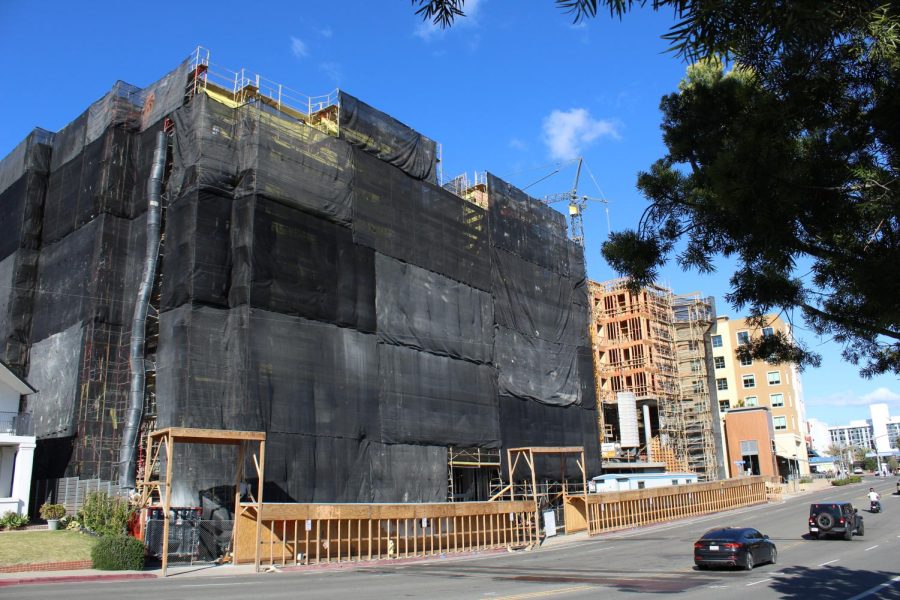What was once the campus McDonald’s is now replaced with housing construction. Students can drive down Montezuma Road and see similar developments of off-campus apartments.
San Diego State University is becoming one of the fastest-growing public universities on the West Coast, with over 35,000 total enrolled students this year alone.
With the rise in enrollment came the need for more student housing in the surrounding areas of SDSU.
These recent student housing development projects can offer a solution to those who need off-campus housing nearby. On average, 11% of California State University students and 5% of University of California students experienced homelessness during the past year.
However, it is unclear if the environmental effects of these developments are being explored.
On Sept. 28, California’s Gov. Gavin Newsom signed Senate Bill 886 into law, exempting qualifying public university development projects from the California Environmental Quality Act (CEQA).
CEQA is a review process intended to prevent significant, avoidable environmental damage from construction activities and inform the government and public about its potential environmental effects, according to the Governor’s Office of Planning and Research.
Under CEQA, any group or individual can anonymously file a lawsuit against a developer for environmental risks—in addition to its review process, which can span from a few weeks to months, lawsuits can halt development progress for even longer.
SDSU’s recent housing projects, such as the developing Topaz Apartments on Montezuma Road, can be exempt from CEQA if the project meets certain criteria by ensuring no emission of additional greenhouse gasses and many other additional factors.
It is unclear if the Topaz Apartments are being built under CEQA as Pierce Education Properties, its property management company, declined to comment.
Some proponents believe the removal of CEQA is the solution to California’s housing crisis. In contrast, others believe there are benefits in researching the project’s environmental effects and how they will lessen the damage.
According to Newsom, he signed SB 886 along with additional housing bills in hopes to create new housing units aiming to help middle and low-income Californians, in addition to creating thousands of jobs.
“California has made historic investments and taken unprecedented actions to tackle the state’s housing crisis over the past four years,” Gov. Newsom said in an official press release on Sept. 28. “But we recognize there’s more work to do—this package of smart, much-needed legislation will help us build new homes while rebuilding the middle class.”
With a vote of 33-1, Sen. John Laird was the one opposing vote when SB 886 had its third reading to the Senate on May 24.
According to Laird, the bill does not solve the college housing problem at hand, but creates more unexplored environmental troubles.
On the Senate floor, Laird said the underlying flaw in this bill is that it claims to streamline the environmental review process, yet in reality, it completely eliminates CEQA for individual housing projects. According to Laird, public universities no longer need to address housing environmental issues under the new bill, even if its city has water or transportation issues.
Similar issues with university housing arose at the University of California, San Diego in 2020.
One of UCSD’s housing projects consisted of five buildings, ranging from nine to 21 stories tall and designed to house up to 2,000 students. A lawsuit was filed by two La Jolla community groups, the La Jolla Shores Association and a local homeowners group, contending that the project violates CEQA through effects on endangered species, traffic, wastewater and greenhouse gasses.
According to the La Jolla Shore Association’s President, Janie Emerson, a settlement was reached after a year-long lawsuit. Emerson shared she is unable to discuss further information on the case, but continues to advocate for CEQA and the research on student housing’s environmental impact.
“The blame isn’t on CEQA,” Emerson said, discussing the new Senate bill. “It was established to see the impact of their development on environmental issues. The whole idea was to protect students and have a healthy world to live in, but developers see (CEQA) as a pain that costs them money.”
Fourth-year hospitality and tourism major Danielle Thompson gave her perspective as a student living in BLVD63, an SDSU off-campus housing community. She said the housing crisis should be solved at the root of the problem: preventing over-enrollment.
“(The university) should admit students based on the amount of housing we have available, not the other way around, and lower the admission rate accordingly,” Thompson said. “It’s good that the new bill is making more housing for students at a faster rate, but the more pollution we create, the fewer resources we have for urbanization.”
According to Emerson, there are other ways to address inadequate housing while also being environmentally responsible. She offers potential solutions to the housing crisis: utilizing the San Diego Trolley system and locating students and faculty in other San Diego areas — still having easy access to SDSU and campuses nearby.
Through the SDSU Transit Center, several mass transit routes connect the university to other parts of San Diego County, including the airport, train station and Snapdragon Stadium. The Green Line Trolley connects east and west routes to SDSU. Spanning 23.6 miles with 26 stops, the trolley travels from downtown San Diego’s Gaslamp Quarter to as north as Santee.
For UCSD students, the university offers the Triton U-Pass, a free universal transit pass program that provides unlimited rides on all trolley rail routes, Metropolitan Transit System and North County Transit District transit buses.
According to Emerson, incorporating free transportation for SDSU students and faculty may kill two birds with one stone: lessening housing development and the potentially harmful environmental effects, as well as providing housing and transportation for those at SDSU.
“It shows you what can be done if you make creative solutions for existing problems,” Emerson said. “We need more of these solutions instead of taking away resources we can’t bring back.”












